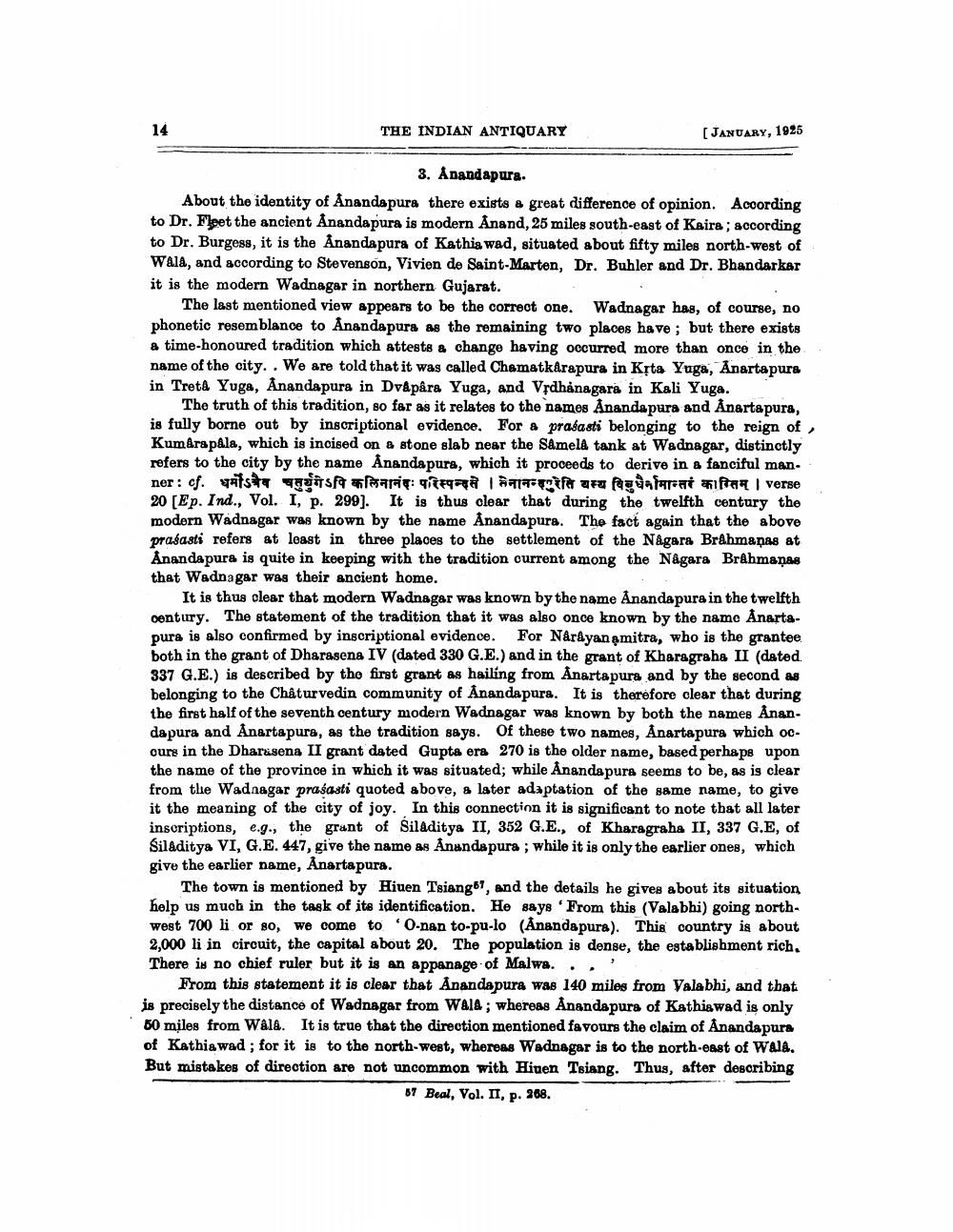________________
THE INDIAN ANTIQUARY
[JANUARY, 1925
3. Anandapura. About the identity of Anandapura there exists a great difference of opinion. Acoording to Dr. Fleet the ancient Anandapura is modern Anand, 25 miles south-east of Kaira, according to Dr. Burgess, it is the Anandapura of Kathis wad, situated about fifty miles north-west of WAIA, and according to Stevenson, Vivien de Saint-Marten, Dr. Buhler and Dr. Bhandarkar it is the modern Wadnagar in northern Gujarat.
The last mentioned view appears to be the correct one. Wadnagar has, of course, no phonetic resemblance to Anandapura as the remaining two places have; but there exists a time-honoured tradition which attests & change having occurred more than once in the name of the city.. We are told that it was called Chamatkarapura in Kịta Yuga, Anartapura in Treta Yuga. Anandapura in Dv&påra Yuga, and Vfdhånagara in Kali Yuga.
The truth of this tradition, so far as it relates to the names Anandapura and Ånartapura, is fully borne out by inscriptional evidence. For a prasasti belonging to the reign of Kumarapala, which is incised on & stone slab near the Samela tank at Wadnagar, distinctly refers to the city by the name Anandapura, which it proceeds to derive in a fanciful man. ner: cf. pats atsa ari: qitroma rotfr ru Rawatara ifta verse 20 Ep. Ind., Vol. I, p. 299). It is thus clear that during the twelfth century the modern Wadnagar was known by the name Anandapura. The fact again that the above prasasti refers at least in three places to the settlement of the Nagara Brahmanas at Anandapura is quite in keeping with the tradition current among the Nagara Brahmaņas that Wadnager was their ancient home.
It is thus clear that modern Wadnagar was known by the name Anandapura in the twelfth century. The statement of the tradition that it was also once known by the name Anartapura is also confirmed by inscriptional evidence. For Narayanamitra, who is the grantee both in the grant of Dharasena IV (dated 330 G.E.) and in the grant of Kharagraha II (dated 337 G.E.) is described by tho first grant as hailing from Anartapura and by the second as belonging to the Chaturvedin community of Anandapura. It is therefore clear that during the first half of the seventh century modern Wadnagar was known by both the names Anan. da pura and Anartapura, as the tradition says. Of these two names, Anartapura which ocours in the Dharasena II grant dated Gupta era 270 is the older name, based perhaps upon the name of the province in which it was situated; while Anandapura seems to be, as is clear from the Wadnagar prasasti quoted above, & later adaptation of the same name, to give it the meaning of the city of joy. In this connection it is significant to note that all later inscriptions, e.g., the grant of Siladitya II, 352 G.E., of Kharagraha II, 337 G.E, of Sil&ditya VI, G.E. 447, give the name as Anandapura ; while it is only the earlier ones, which give the earlier name, Anartapura.
The town is mentioned by Hiuen Tsiang 67, and the details he gives about its situation help us much in the task of its identification. He says 'From this (Valabhi) going northwest 700 li or so, we come to '0-nan to-pu-lo (Anandapura). This country is about 2,000 li in circuit, the capital about 20. The population is dense, the establishment rich. There is no chief ruler but it is an appanage of Malwa...!
From this statement it is clear that Anandapura was 140 miles from Valabhi, and that is precisely the distance of Wadnagar from WAIA; whereas Anandapura of Kathiawad is only 50 miles from Wall. It is true that the direction mentioned favours the claim of Anandapura of Kathiawad; for it is to the north-west, whereas Wednagar is to the north-east of Wala. But mistakes of direction are not uncommon with Hinen Tsiang. Thus, after describing
57 Beal, Vol. II, p. 268.




